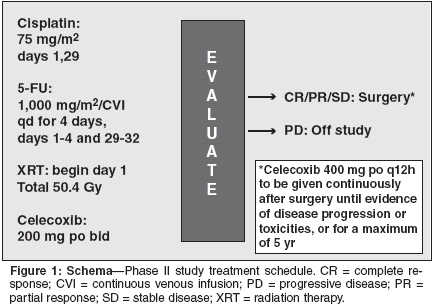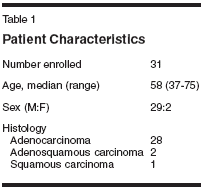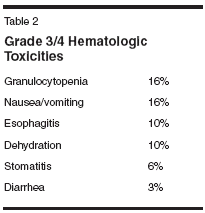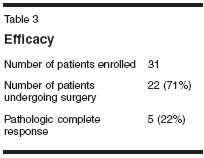Cisplatin, Fluorouracil, Celecoxib, and RT in Resectable Esophageal Cancer: Preliminary Results
Esophageal cancer frequently expresses cyclooxygenase-2 (COX-2)enzyme. In preclinical studies, COX-2 inhibition results in decreasedcell proliferation and potentiation of chemotherapy and radiation. Wereport preliminary results of a phase II study conducted by the HoosierOncology Group in patients with potentially resectable esophageal cancer.All patients received cisplatin at 75 mg/m2 given on days 1 and 29and fluorouracil (5-FU) at 1,000 mg/m2 on days 1 to 4 and 29 to 32with radiation (50.4 Gy beginning on day 1). Celecoxib (Celebrex) wasadministered at 200 mg orally twice daily beginning on day 1 untilsurgery and then at 400 mg orally twice daily until disease progressionor unexpected toxicities, or for a maximum of 5 years. Esophagectomywas performed 4 to 6 weeks after completion of chemoradiation. Theprimary study end point was pathologic complete response (pCR). Secondaryend points included response rate, toxicity, overall survival, andcorrelation between COX-2 expression and pCR. Thirty-one patientswere enrolled from March 2001 to July 2002. Respective grade 3/4 toxicitieswere experienced by 58%/19% of patients, and consisted of granulocytopenia(16%), nausea/vomiting (16%), esophagitis (10%), dehydration(10%), stomatitis (6%), and diarrhea (3%). Seven patients (24%)required initiation of enteral feedings. There have been seven deathsso far, resulting from postoperative complications (2), pulmonary embolism(1), pneumonia (1), and progressive disease (3). Of the 22 patients(71%) who underwent surgery, 5 had pCR (22%). We concludethat the addition of celecoxib to chemoradiation is well tolerated. ThepCR rate of 22% in this study is similar to that reported with the use ofpreoperative chemoradiation in other trials. Further follow-up is necessaryto assess the impact of maintenance therapy with celecoxib onoverall survival.
Esophageal cancer frequently expresses cyclooxygenase-2 (COX-2) enzyme. In preclinical studies, COX-2 inhibition results in decreased cell proliferation and potentiation of chemotherapy and radiation. We report preliminary results of a phase II study conducted by the Hoosier Oncology Group in patients with potentially resectable esophageal cancer. All patients received cisplatin at 75 mg/m2 given on days 1 and 29 and fluorouracil (5-FU) at 1,000 mg/m2 on days 1 to 4 and 29 to 32 with radiation (50.4 Gy beginning on day 1). Celecoxib (Celebrex) was administered at 200 mg orally twice daily beginning on day 1 until surgery and then at 400 mg orally twice daily until disease progression or unexpected toxicities, or for a maximum of 5 years. Esophagectomy was performed 4 to 6 weeks after completion of chemoradiation. The primary study end point was pathologic complete response (pCR). Secondary end points included response rate, toxicity, overall survival, and correlation between COX-2 expression and pCR. Thirty-one patients were enrolled from March 2001 to July 2002. Respective grade 3/4 toxicities were experienced by 58%/19% of patients, and consisted of granulocytopenia (16%), nausea/vomiting (16%), esophagitis (10%), dehydration (10%), stomatitis (6%), and diarrhea (3%). Seven patients (24%) required initiation of enteral feedings. There have been seven deaths so far, resulting from postoperative complications (2), pulmonary embolism (1), pneumonia (1), and progressive disease (3). Of the 22 patients (71%) who underwent surgery, 5 had pCR (22%). We conclude that the addition of celecoxib to chemoradiation is well tolerated. The pCR rate of 22% in this study is similar to that reported with the use of preoperative chemoradiation in other trials. Further follow-up is necessary to assess the impact of maintenance therapy with celecoxib on overall survival.
Although relatively uncommon in the United States, esophageal cancer is the sixth leading cause of cancer-related mortality worldwide.[1] Approximately 14,250 patients are predicted to be diagnosed with esophageal cancer in the United States in 2004.[2] In addition, the incidence of adenocarcinoma of the esophagus among Caucasian males in the United States has increased significantly over the past 2 decades.[3] At the time of initial presentation, more than 50% of patients have locally advanced or metastatic disease. Even in patients with seemingly lo calized disease, surgery as a singlemodality therapy produces 5-year survival rates of only approximately 15% to 24%.[1] Preoperative chemothera- py has been evaluated in two large multi-institutional studies, but has achieved conflicting results. The US Intergroup study that included 440 patients did not find any benefit with preoperative therapy.[4] However, the larger British study reported improved survival with preoperative chemotherapy.[ 5] While the reasons for differences in the outcome are not clear, the US study required more thorough staging with computed tomography (CT) scan, and had a longer duration of preoperative therapy. Several small randomized studies reported no benefit from preoperative chemotherapy and radiation.[6-10] Two large, adequately powered studies also failed to demonstrate a survival advantage with preoperative chemotherapy and radiation.[11,12] Walsh and colleagues reported an improvement in survival with preoperative chemotherapy and radiation.[13] Despite this lone positive (albeit controversial) study, the use of preoperative chemotherapy and radiation has become a "standard of care" among the practitioners of esophageal cancer in the United States. However, a large phase III study in the United States that is randomizing patients with resectable esophageal cancer to surgery alone or preoperative chemotherapy and radiation followed by surgery had to be closed prematurely because of poor accrual. Several ongoing phase II studies in the United States continue to investigate preoperative chemotherapy and radiation in patients with resectable esophageal cancer. The role of the cyclooxygenase-2 (COX-2) enzyme has been studied extensively in a variety of malignancies.[ 14] The insertion of the COX-2 gene into a rat intestinal epithelial cell (RIE) resulted in overexpression of proto-oncogene bcl-2, with inhibition of cellular apoptosis.[15] Notably, COX-2 inhibition has been associat-ed with apoptosis, decreased cell proliferation, and inhibition of angiogenesis.[ 16,17] COX-2 is upregulated in response to radiation therapy, and addition of COX-2 to radiation has been reported to produce synergism. Significantly, more than 75% of esophageal cancer specimens overexpress COX-2.[18] The Hoosier Oncology Group (HOG) launched a phase II study combining celecoxib (Celebrex), a selective COX-2 inhibitor, to the well-established combination of cisplatin, fluorouracil (5-FU), and radiation prior to surgical resection in patients with localized esophageal cancer.

Materials and Methods Patients with histologic or cytologic diagnosis of esophageal cancer who are deemed resectable were eligible if they possessed good Eastern Cooperative Oncology Group (ECOG) performance status (0 to 1) and adequate bone marrow liver and renal function. Eligible patients received cisplatin at 75 mg/m2 given on days 1 and 29 plus 5-FU at 1,000 mg/m2 on days 1 to 4 and 29 to 32, with radiation therapy (RT, 50.4 Gy beginning on day 1). Celecoxib was administered at 200 mg orally twice daily from day 1 until surgery and then 400 mg twice a day until disease progression or unexpected toxicities, or for a maximum of 5 years. Esophagectomy was performed 4 to 6 weeks after completion of chemotherapy and radiation (see Figure 1). The primary study end point was pathologic complete response (pCR). Secondary end points included response rate, toxicity, overall survival, and correlation between COX-2 expression and pCR. We utilized a Simon two-stage design. A pathologic response (CR or nearly CR) rate of less than 5% was considered definitely low, and one greater than 25% was considered significant enough to consider further investigation. In the first stage, we accrued nine patients. Based on the responses observed in this stage, we proceeded to accrue an additional 21 patients. This two-stage design will provide approximately 5% of type I error probability for H0 (P = .05) and 90% of power for H1 (P = .25).



Results The demographics of the accrued patients are summarized in Table 1. Thirty-one patients were enrolled from March 2001 to July 2002. Ninetythree percent of patients were male; 7% females, with a median age of 58 years (range: 37-75). The majority of patients had adenocarcinoma histology (90%) and an ECOG performance status of 0 (81%). Respective grade 3/4 toxicities (listed in Table 2) were experienced by 58%/19% of patients, and these included granulocytopenia (16%), nausea/vomiting (16%), esophagitis (10%), dehydration (10%), stomatitis (6%), and diarrhea (3%). Seven patients (24%) required initiation of enteral feedings. There have been seven deaths so far. Three patients died of postoperative complications, two from pulmonary embolism, and one each from pneumonia and progressive disease. Of the 31 patients enrolled in the study, 22 underwent surgery at the primary site or in the adjacent lymph nodes (Table 3). Survival data and correlation between COX-2 expression and pathologic complete response will be reported at a future date as the data mature. Discussion and Conclusion Pathologic complete response may be a surrogate marker to assess the effectiveness of combined-modality therapy, as previously reported in three nonrandomized trials that investigated a relationship between pCR and improved survival.[19-21] In the Southwest Oncology Group Trial of Poplin et al,[19] the actuarial 3-year survival rate was 45% in resected patients with pCR, compared to 16% for all study patients. Seydel and colleagues reported for the Radiation Therapy Oncology Group (RTOG) Pilot Study[20] (N = 43) a 2-year survival rate of 33% for patients who achieved a pCR in the esophagectomy specimen vs 15% for the study population. In a study of 42 patients, Forastiere et al[21] reported a median survival of 70 months with a 5-year survival of 60% for 36 patients who achieved a pCR. The respective pCR rates in these three studies were 25%, 29%, and 88%. Other phase II studies reported pCR rates of between 40% and 47% with preoperative cisplatin and 5-FU combined with 30 to 45 Gy of radiation dose delivered in 15 to 22 fractions.[21-23] In various randomized phase III trials comparing neoadjuvant (induction) chemoradiation plus surgery vs surgery alone in patients with resectable disease, the observed pCR rates ranged between 22% and 25%. LePrise et al[7] reported a 10% pCR rate in 41 patients treated with a 20- Gy radiation dose in 10 fractions combined with cisplatin and 5-FU. Bosset and colleagues[11] reported a pCR rate of 20% in 139 patients treated with split-course radiotherapy (two courses of 3.7 Gy daily for 5 days with a 2-week gap between courses) administered with cisplatin, 80 mg/m2 on days 0 to 2 before radiotherapy. Walsh et al[13] reported a 22% pCR among 58 patients treated with 40 Gy given in 15 fractions with cisplatin and 5-FU. Urba and collaborators[10] randomized 100 patients to concurrent cisplatin, vinblastine, and 5-FU, and hyperfractionated radiation therapy (1.5 Gy given twice daily to 45 Gy) or to surgery alone. The reported pCR was 28%. The pCR rates achieved with the addition of celecoxib to the conventional cisplatin, 5-FU, and radiation therapy in resectable esophageal cancer achieved in this study were comparable to those reported for a number of preoperative chemoradiation regimens. When the study design was initiated, safety data regarding the concomitant use of celecoxib and radiation were unavailable. Thus we elected to administer celecoxib at 200 mg twice daily instead of the more commonly used higher doses of celecoxib, 400 mg orally twice daily used in many ongoing clinical studies. It is unknown whether higher doses of celecoxib would have improved pCR rates. Nearly two-thirds of patients relapse and die from progressive disease within 3 years despite curative surgery, presumably from micrometastatic disease. Notably, inhibition of COX-2 has been associated with decreased angiogenesis and invasion. Whether maintenance therapy of celecoxib has a role in this setting will only be discerned with longer followup and randomized investigation.
Disclosures:
Dr. Govindan has received research support and honoraria for speaking engagements from Pfizer.
References:
1. Enzinger PC, Mayer RJ: Esophageal cancer. N Engl J Med 349:2241-2252, 2003.
2. Jemal A, Tiwari RC, Murray T, et al: Cancer statistics, 2004. CA Cancer J Clin 54:8-29, 2004.
3. Devesa SS, Blot WJ, Fraumeni JF, Jr: Changing patterns in the incidence of esophageal and gastric carcinoma in the United States. Cancer 83:2049-2053, 1998.
4. Kelsen DP, Ginsberg R, Pajak TF, et al: Chemotherapy followed by surgery compared with surgery alone for localized esophageal cancer. N Engl J Med 339:1979-1984, 1998.
5. Group MRCOCW: Surgical resection with or without preoperative chemotherapy in oesophageal cancer: A randomised controlled trial. Lancet 359:1727-1733, 2002.
6. Nygaard K, Hagen S, Hansen HS, et al: Pre-operative radiotherapy prolongs survival in operable esophageal carcinoma: A randomized, multicenter study of pre-operative radiotherapy and chemotherapy. The second Scandinavian trial in esophageal cancer. World J Surg 16:1104-1109 (discussion 1110), 1992.
7. Le Prise E, Etienne PL, Meunier B, et al: A randomized study of chemotherapy, radiation therapy, and surgery versus surgery for localized squamous cell carcinoma of the esophagus. Cancer 73:1779-1784, 1994.
8. Apinop C, Puttisak P, Preecha N: A prospective study of combined therapy in esophageal cancer. Hepatogastroenterology 41:391- 393, 1994.
9. Law S, Kwong D, Tung H, et al: Preoperative chemoradiation for squamous cell oesophageal cancer: A prospective randomized trial (abstract). Can J Gastroenterol 12:56B, 1998.
10. Urba SG, Orringer MB, Turrisi A, et al: Randomized trial of preoperative chemoradiation versus surgery alone in patients with locoregional esophageal carcinoma. J Clin Oncol 19:305-313, 2001.
11. Bosset JF, Gignoux M, Triboulet JP, et al: Chemoradiotherapy followed by surgery compared with surgery alone in squamous-cell cancer of the esophagus. N Engl J Med 337:161-167, 1997.
12. Burmeister BH, Smithers BM, Fitzgerald L, et al: A randomized phase III trial of preoperative chemoradiation followed by surgery (CR-S) versus surgery alone (S) for localized resectable cancer of the esophagus (abstract 518). Proc Am Soc Clin Oncol 21:130a, 2002.
13. Walsh TN, Noonan N, Hollywood D, et al: A comparison of multimodal therapy and surgery for esophageal adenocarcinoma. N Engl J Med 335:462-467, 1996.
14. Choy H, Milas L: Enhancing radiotherapy with cyclooxygenase-2 enzyme inhibitors: A rational advance? J Natl Cancer Inst 95:1440-1452, 2003.
15. Tsujii M, DuBois RN: Alterations in cellular adhesion and apoptosis in epithelial cells overexpressing prostaglandin endoperoxide synthase 2. Cell 83:493-501, 1995.
16. Masferrer J: Approach to angiogenesis inhibition based on cyclooygenase-2. Cancer J 7(suppl 3):S144-S150, 2001.
17. Leahy KM, Ornberg RL, Wang Y, et al: Cyclooxygenase-2 inhibition by celecoxib reduces proliferation and induces apoptosis in angiogenic endothelial cells in vivo. Cancer Res 62:625-631, 2002.
18. Zimmermann KC, Sarbia M, Weber AA, et al: Cyclooxygenase-2 expression in human esophageal carcinoma. Cancer Res 59:198-204, 1999.
19. Poplin F, Fleming T, Leichman L, et al: Combined therapies for squamous cell carcinoma of the esophagus: Southwest Oncology Group Study (SWOG-8037). J Clin Oncol 5:622-628, 1987.
20. Seydel HG, Wichman L, Byhardt R, et al: Preoperative radiation therapy and chemotherapy for localized squamous cell carcinoma of the esophagus: An RTOG study. Int J Radiat Oncol Biol Phys 14:33-35, 1988.
21. Forastiere AA, Orringer MB, Perez- Tamayo C, et al: Preoperative chemoradiation followed by transtriatol esophagectomy for carcinoma of esophagus. J Clin Oncol 11:1118- 1123, 1993.
22. Jones DR, Detterbeck FC, Egan TM, et al: Induction chemoradiotherapy followed by esophagectomy in patients with carcinoma of esophagus. Ann Thorac Surg 64:185-191, 1997.
23. Leichman L, Steiger Z, Seydel HG, et al: Preoperative chemotherapy and radiation therapy for patients with cancer of the esophagus: A potentially curative approach. J Clin Oncol 2:75-79, 1984.